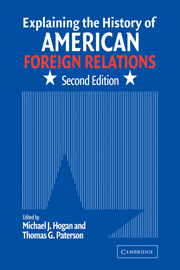Book contents
- Frontmatter
- Contents
- Preface to the Second Edition
- Contributors
- 1 Introduction
- 2 Defining and Doing the History of United States Foreign Relations : A Primer
- 3 Toward a Pluralist Vision : The Study of American Foreign Relations as International History and National History
- 4 Theories of International Relations
- 5 Bureaucratic Politics
- 6 Psychology
- 7 National Security
- 8 Corporatism
- 9 World Systems
- 10 Dependency
- 11 Considering Borders
- 12 The Global Frontier : Comparative History and the Frontier-Borderlands Approach
- 13 Modernization Theory
- 14 Ideology
- 15 Culture and International History
- 16 Cultural Transfer
- 17 Reading for Meaning : Theory, Language, and Metaphor
- 18 What's Gender Got to Do with It? Gender History as Foreign Relations History
- 19 Race to Insight: The United States and the World, White Supremacy and Foreign Affairs
- 20 Memory and Understanding U.S. Foreign Relations
- Index
11 - Considering Borders
Published online by Cambridge University Press: 05 June 2012
- Frontmatter
- Contents
- Preface to the Second Edition
- Contributors
- 1 Introduction
- 2 Defining and Doing the History of United States Foreign Relations : A Primer
- 3 Toward a Pluralist Vision : The Study of American Foreign Relations as International History and National History
- 4 Theories of International Relations
- 5 Bureaucratic Politics
- 6 Psychology
- 7 National Security
- 8 Corporatism
- 9 World Systems
- 10 Dependency
- 11 Considering Borders
- 12 The Global Frontier : Comparative History and the Frontier-Borderlands Approach
- 13 Modernization Theory
- 14 Ideology
- 15 Culture and International History
- 16 Cultural Transfer
- 17 Reading for Meaning : Theory, Language, and Metaphor
- 18 What's Gender Got to Do with It? Gender History as Foreign Relations History
- 19 Race to Insight: The United States and the World, White Supremacy and Foreign Affairs
- 20 Memory and Understanding U.S. Foreign Relations
- Index
Summary
This essay beckons historians of U.S. international relations to borders– those spaces at which different systems of meaning and organization intersect.
Borders – both geographic and figurative – can be messy places. They may produce conflict, demoralization, fear, and oppression. They may generate hybridization, creativity, and liberation. Borders are no one way or they would not be borders. The Berlin Wall marked a border. The metropolitan area of San Diego and Tijuana straddles a border. The journal in our field, Diplomatic History, has been most controversial, and I think most successful, when it has pushed the borders of the field. All of these provide apt, but different, metaphors of the dangers and opportunities represented at borders. Conflicted zones, borders may be unsettled and postmodern in their juxtapositions, and – for that very reason – they often raise concerns over control and become sites for oppression and policing.
Writing histories of American foreign relations is involved with – and complicated by – borders. The traditional scholarship of diplomatic history dealt largely with bounded states in an international system; more recently, economic and cultural interactions among nonstate actors have attracted considerable attention. In addition, historians of foreign relations now work within a larger universe of scholarly discourse that blurs disciplinary borders and debates the saliency of modernist categories and assumptions about the writing of history. Interrogating the borders of politics and power, of culture and knowledge, is what this field – perhaps more than any other – should strive to do best.
- Type
- Chapter
- Information
- Explaining the History of American Foreign Relations , pp. 176 - 193Publisher: Cambridge University PressPrint publication year: 2004
- 5
- Cited by

